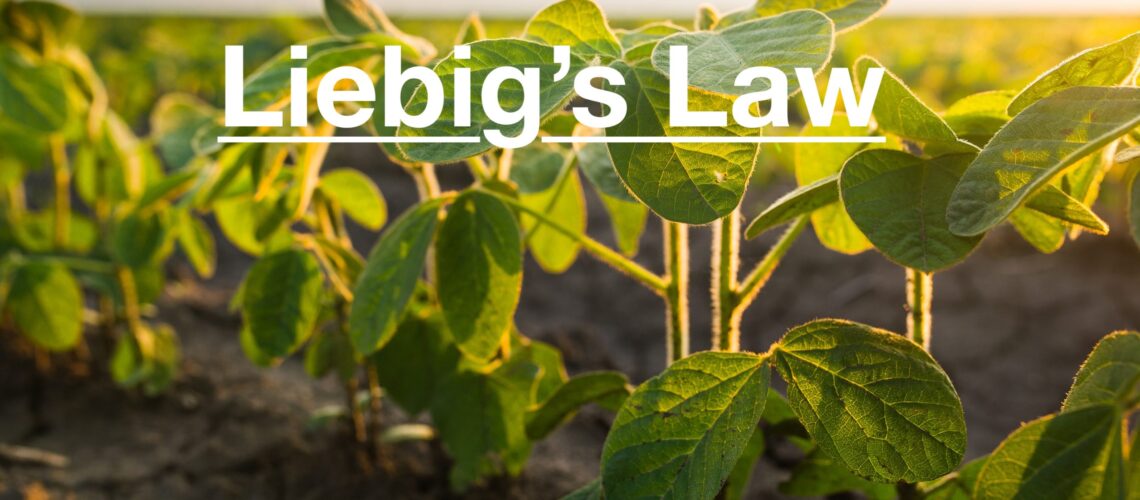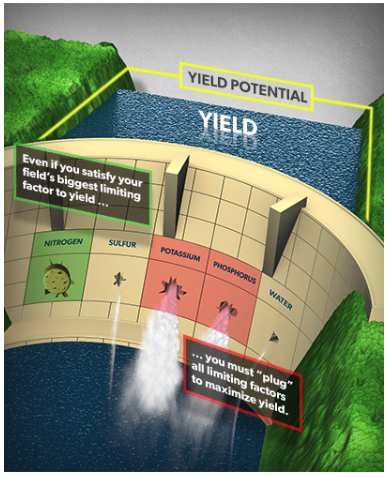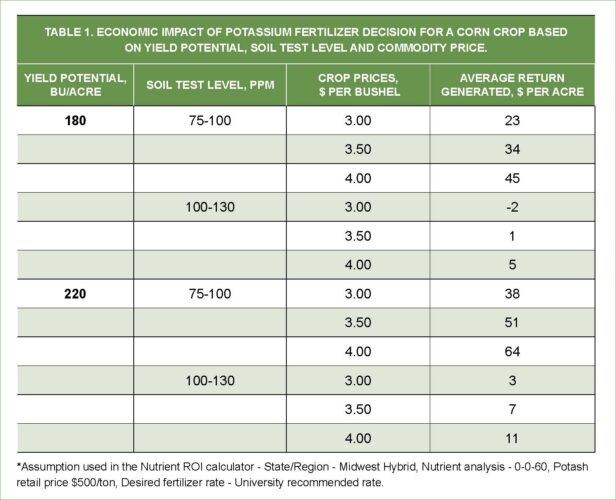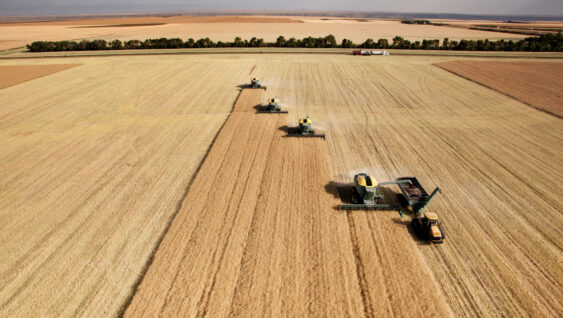Liebig’s Law of the Minimum

Nutrient management is one of the most important aspects to a successful crop. Understanding Liebig’s law of the minimum can help you maximize the results of your fertilizer investment and achieve the highest possible yields. Make certain you know just how much yield – and economic return – you are leaving out in the field before making a decision for any crop.
What is Liebig’s Law?

Liebig’s law states that the yield achievable is dictated by the nutrient that is most limiting. One way to visualize this concept is to illustrate it with a dam. The water being held back by the dam represents yield potential. Holes in the dam represent yield limiting factors that allow yield potential to be decreased as they leak. The goal is to identify which holes are leaking and plug them to maintain as much yield potential as possible.
For most non-legume crops (corn and wheat as examples), nitrogen is often considered the most important leak to plug, and that is generally a correct thought. Simply plugging the nitrogen leak, without considering other leaks in the dam, can lead to considerable yield loss. As illustrated in the figure, the nitrogen leak has been securely plugged, but there are considerable leaks coming from inadequate potassium and phosphorus. To get the most out of your fertilizer investment, it’s important to ensure you are addressing as many leaks as possible.
Watch the video to learn more about this modern model of Liebig’s law and listen to Dr. Robert Mullen explain the importance of not ignoring other yield-limiting factors.
For those who have attended a soil fertility meeting or a crop nutrient management class, you have seen the barrel concept (Figure 1) used to illustrate Liebig’s law of the minimum. Stated using the barrel analogy, the amount of water a barrel will hold is a function of the length of the shortest stave.

Let’s assume that potassium is the most limiting factor. If a field’s yield potential is 220 bushels per acre (with adequate potassium nutrition), but soil test potassium level will only allow yield to reach 80 percent of the maximum, the actual yield achievable is 176 bushels per acre. This scenario assumes that all other nutrients are supplied at 100 percent sufficient levels (an assumption most forget to include when discussing the law of the minimum).
Remember, the goal of any agronomist is to proactively identify and remove yield-limiting factors. This concept applies to soil fertility, weed management, pathology, entomology and other agronomic considerations.
How does this apply to allocating your fertilizer dollar? Blindly cutting potassium or phosphorus and focusing the bulk of your fertilizer investment on nitrogen can be a yield-limiting, and profit-decreasing, decision. This is especially true if potassium or phosphorus have limited availability based upon soil test. The crop will respond to applying nitrogen fertilizer, but the yield achieved will be limited based on the extent of potassium and phosphorus inadequacy.
Figure 2 is a simple visualization of this concept. Notice the light green line (representing corn yield with inadequate phosphorus) does increase as nitrogen application increases. However, also note that the dark green line (representing corn yield with adequate phosphorus) allows for a higher maximum achievable yield when nitrogen and phosphorus are supplied. In this example, the yield achievable with both adequate phosphorus and nitrogen is 20 bushels higher than with adequate nitrogen alone.

More Nutrient Interactions
Some nutrient inadequacies can actually affect the crop’s ability to utilize other nutrients supplied. The most commonly mentioned nutrient interaction is nitrogen and potassium.
The nature of the interaction is such that whenever potassium is inadequate, the crop can require more nitrogen to achieve the optimal nitrogen rate (the rate where yield is maximized) and typically at a lower yield level. A video discussing this interaction is available above.
In Figure 3, the light green line represents corn response to nitrogen whenever potassium is not adequately supplied. Note how corn yield never quite reaches a maximum, i.e., the yield is still increasing in response to an increased supply of nitrogen. The dark green line represents a scenario where adequate potassium has been supplied. Notice how the corn crop achieves a higher yield, and reaches it at a lower nitrogen rate, compared to the inadequate potassium scenario.

Another benefit of maintaining adequate potassium availability in soil is the potential interaction with phosphorus. Unpublished field research conducted at Ohio State University from 1994-1999 revealed that in situations where soil test potassium was below the established critical level, corn and soybean yields could decrease by increasing the phosphorus fertilization rate. This yield decrease occurred three out of seven research years in corn, and three out of seven research years in soybeans. The exact physiological mechanism that would cause crop yield to decrease as a result of increasing the phosphorus application rate in a soil environment with inadequate potassium is not well understood.
Research conducted on alfalfa reveals a similar interaction between phosphorus and potassium. This study was conducted over seven years at Purdue University (Berg et al., 2005). During the final two years of the study, it was noted that plots receiving no potassium fertilization experienced decreased alfalfa yield by increasing the phosphorus fertilization rate. Therefore, forgoing potassium fertilization not only limits production, but supplying additional phosphorus combined with poor potassium fertility can actually decrease productivity.
Data such as this points to the importance of identifying and removing each yield-limiting factor because nutrient interactions can and do occur.
Making the Agronomic… Economic
These agronomic concepts and realities obviously have an economic impact on the farming operation. Opting to skip fertilization of potassium or phosphorus (or really any limiting nutrient) in an effort to save money can actually decrease total economic profit.
Try the eKonomics Nutrient ROI (return on investment) Tool to help you understand just how much average return is generated from your fertilizer investment.
Table 1 illustrates how yield potential, soil test level and commodity pricing influence the average economic return from potassium fertilization. Cutting potassium fertilization when soil test is below 100 ppm (parts per million) represents considerable lost economic return especially as commodity price increases. The economic penalty for cutting potassium fertilization decreases as soil test level climbs above 100 ppm, but as the commodity price increases the return-not-realized if fertilization is skipped also increases.

Allocating Your Fertilizer Dollar, Where Should You Invest?
There are annually several articles published in trade magazines and University bulletins discussing how farmers should make adjustments to input purchases (specifically fertilizer) to increase the profitability of their farming operations.
When budgets get tighter, one common recommendation is cutting back on potassium and phosphorus. This may be an option if you have an adequate supply of these nutrients in your soil. However, cutting back without evaluating soil test levels, and considering the agronomic and economic implications, is likely not a good decision.
The purpose of this article is to illustrate the importance of a good crop nutrition program, and why blindly cutting back on some fertilizer inputs could actually cost you money.

References
- Berg, W.K, S.M. Cunningham, S.M. Brouder, B.C. Joern, K.D. Johnson, J. Santini, and J.J. Volenec. Influence of phosphorus and potassium on alfalfa yield and yield components. Crop Science Society of America Journal 45:297-304.
- Potassium interactions with other nutrients. 1998. Better Crops 82:12-13.


